Renters in These States Are Getting Hit Hard by the Pandemic Economy
Renters around the country are struggling.
While COVID-19 has economically affected millions, renters are some of the hardest-hit. Because they're often less financially secure, they face difficulties that homeowners don't -- especially if they lose their jobs, are furloughed, or have other troubles getting paid.
And renters in some states have a harder time than others.
Using government data, we've identified 11 states and one territory where unemployment rates are high and renters pay a large percentage of their income for housing.
This is a simplified approach to a complex issue. But it's intended to highlight these circumstances, as it's important that renters not lose their housing during this coronavirus pandemic -- especially as state bans on evictions start to lift throughout the country in the coming weeks.
Why renters are getting hit harder than homeowners
Just about everyone has been affected by the novel coronavirus in some way. Why is it worse for renters?
- Renters have less housing security than homeowners. They're at the mercy of landlords and can be priced out of their homes. Homeowners with fixed-rate mortgages will never see their monthly payments rise, and those with paid-off mortgages can stay put as long as they pay their taxes.
- Homeowners may qualify for a home equity loan or a cash-out refinance to get through a period of unemployment. Renters don't have that option.
- Renters are more likely than homeowners to have low household incomes.
Some renters are especially vulnerable to the pandemic economy. This includes renters who:
- already spend at least 30% of their incomes on housing (this includes 47% of renters);
- earn less than 30% of their area's pre-pandemic median income (11 million at last count);
- work in hard-hit industries like hospitality and tourism;
- live in states with high unemployment rates or low unemployment benefits;
- had to stop working to care for their children due to closures;
- are undocumented immigrants and ineligible for many government-administered social programs;
- are freelancers or gig workers with little access to unemployment compensation; and those who
- don't meet wage history requirements for unemployment compensation because of health-related job loss.
Renter protections
The CARES Act, which became law on March 27, 2020, implemented a 120-day eviction moratorium that applied to about 25% of renters nationwide.
Some cities, counties, and states imposed additional eviction moratoriums to help renters. Political leaders in these jurisdictions recognized that a torrent of evictions, and the resulting increase in homelessness and overcrowding, could only hasten the virus's spread, further overwhelm the healthcare system, kill more people, and prolong the return to high employment.
But eviction isn't the only financial threat to renters, so it's still important to understand where renters are hurting.
How we ranked the states
We ranked all 50 states, as well as the District of Columbia and Puerto Rico, on two factors.
The first was rent affordability, calculated as the percentage of the median renter's income that rent consumes. For example, the median rent in Puerto Rico is $484 per month -- but that takes up almost 50% of the median renter's monthly income of $979. Puerto Rico has the least affordable rent in our ranking, earning it a rank of 52.
The second was the state's unemployment rate as of May 21, 2020. Nevada's unemployment rate of 23.52% is the highest in the country, earning it a rank of 52.
Both factors were equally weighted, resulting in several ties. For this reason, we included the top 12 states (or, more accurately, 11 states and a territory) instead of the top 10.
A note about the ranking
While we know that not everyone who rents is financially disadvantaged and that not everyone who claims unemployment is a renter, there's a connection between renters and the industries that have been hit hardest by COVID-19.
Kneebone and Murray point out, for example, that almost 50 million people who live in renter households are likely experiencing job or income losses. And an Amherst Market Commentary from March 2020 predicts that lower-middle-income households -- disproportionately made up of hourly wage earners -- will be most economically affected by the pandemic. "A disproportionate share of these affected workers are renters who will need payment support," says the commentary.
It goes on to show that hourly wage workers make up above-average percentages of the employees in retail, manufacturing, and leisure and hospitality. While transportation and utilities are below average, hourly wage workers still make up over 40% of the workforce -- and transportation is among the industries struggling the most during the pandemic.
12. (Tie) Massachusetts

Image source: Getty Images.
Rent affordability rank (lower is better): 45th
Unemployment rank (lower is better): 34th
Percentage of households that rent: 38.24%
Renters' median annual income: $45,629
Median monthly rent: $1,295
Rent as a percentage of monthly income: 34.06%
State unemployment rate: 16.13%
Unemployment in Massachusetts isn't that bad relative to the other states on our list, but it's still above 16% -- a rate unseen in any state before the pandemic. To put this rate in perspective, during the Great Recession, U.S. unemployment peaked at 10%.
Massachusetts counties have endured some of the highest COVID-19 infection rates in the country. Suffolk County, which includes Boston and Chelsea, has had more than 2,100 cases per 100,000 residents.
12. (Tie) New Jersey
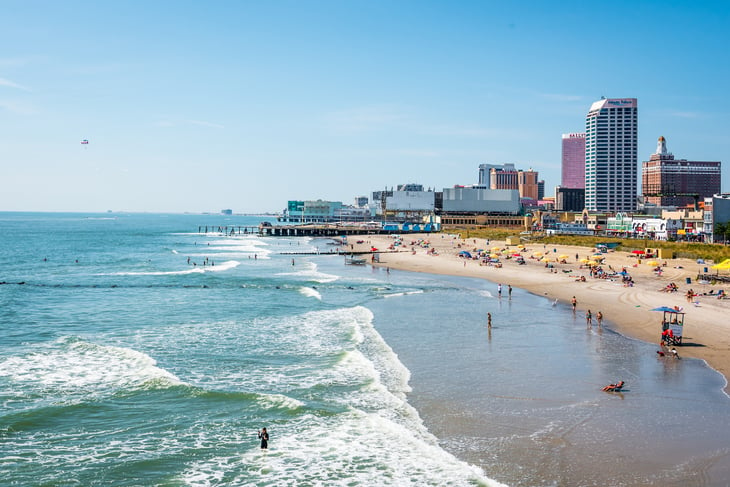
Image source: Getty Images.
Rent affordability rank: 40th
Unemployment rank: 39th
Percentage of households that rent: 36.02%
Renters' median annual income: $48,925
Median monthly rent: $1,336
Rent as a percentage of monthly income: 32.77%
State unemployment rate: 17.77%
New Jersey has the country's seconxtad-highest COVID-19 death toll. However, with hospitalizations, infection rates, and death rates declining, the state is cautiously reopening, which should improve unemployment numbers and help some renters get back on their feet.
Will those improvements be sustainable? We'll find out in a few weeks.
10. Michigan

Image source: Getty Images.
Rent affordability rank: 29th
Unemployment rank: 51st
Percentage of households that rent: 28.81%
Renters' median annual income: $32,803
Median monthly rent: $861
Rent as a percentage of monthly income: 31.50%
State unemployment rate: 22.6%
While rent is more affordable in Michigan than anywhere else on our list, it still takes up more than 30% of the median renter's income, and the state's unemployment rate is second only to Nevada's. The state's seven-day moving average of new cases has trended downward since early April after fast, strict closures from governor Gretchen Whitmer.
Wayne County, which includes the already beleaguered city of Detroit, has been hit especially hard, with a case rate of 1,127 per 100,000 residents and 2,359 deaths. The state's fatality rate from the virus is 9.56%, and 41% of the deceased were black -- while only 14% of Michiganders overall are black.
9. Hawaii

Image source: Getty Images.
Rent affordability rank: 43rd
Unemployment rank: 40th
Percentage of households that rent: 41.72%
Renters' median annual income: $57,180
Median monthly rent: $1,613
Rent as a percentage of monthly income: 33.85%
State unemployment rate: 17.82%
Renters in Hawaii have the highest median monthly income in the nation, but they also have the highest monthly rent. Why? Hawaii has a high cost of living, but another factor is vacation rentals. Investors buy up rental properties, decreasing supply and driving rents up. Even if rents go down because of the pandemic, tourism will take a hit, too -- so it may be a wash.
The infection rate in Hawaii is very low, with just 642 cases and 17 deaths. The mandatory 14-day quarantine Hawaii imposed on everyone entering the state may be one reason cases have stayed under control.
8. Nevada

Image source: Getty Images.
Rent affordability rank: 32nd
Unemployment rank: 52nd
Percentage of households that rent: 43.22%
Renters' median annual income: $41,859
Median monthly rent: $1,108
Rent as a percentage of monthly income: 31.76%
State unemployment rate: 23.52%
In April, Nevada's 28.2% unemployment rate set a record for a U.S. state. And, as in many states, Nevada's unemployment insurance system has been overwhelmed, creating payout delays for laid-off workers seeking assistance.
In a state whose economy leans heavily on visitors from around the world, it's easy to see why unemployment is so high. MGM Resorts had to furlough 63,000 workers and recently said some of those layoffs could become permanent at the end of August.
7. California
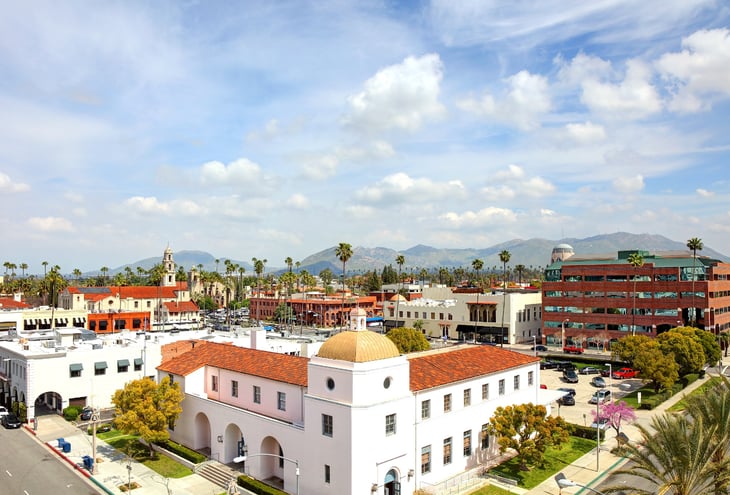
Image source: Getty Images.
Rent affordability rank: 49th
Unemployment rank: 36th
Percentage of households that rent: 45.18%
Renters' median annual income: $52,348
Median monthly rent: $1,520
Rent as a percentage of monthly income: 34.84%
State unemployment rate: 16.45%
With some of the least affordable rents in the nation, California's renters may be ill-equipped to deal with double-digit employment. The Golden State also has the third-highest percentage of renters in the nation after D.C. and New York.
California's unemployment rank doesn't look so bad in the current climate. But here's the problem: Not counted in the official unemployment rate are undocumented workers, who aren't eligible for unemployment compensation and who make up about 10% of the state's labor force.
6. Louisiana
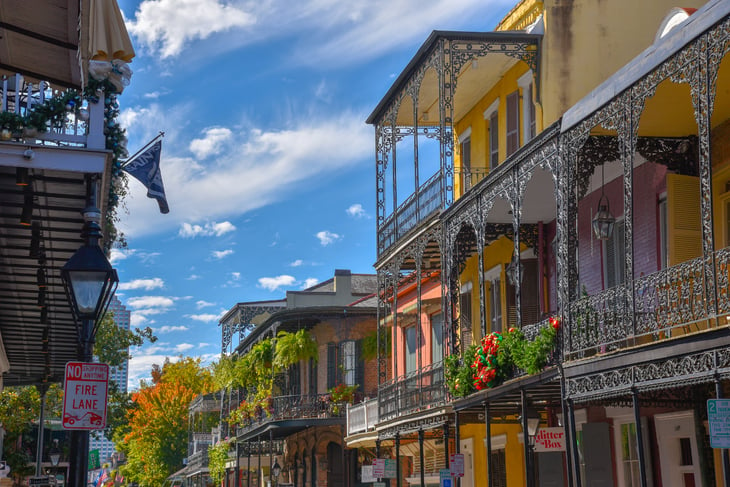
Image source: Getty Images.
Rent affordability rank: 51st
Unemployment rank: 38th
Percentage of households that rent: 34.52%
Renters' median annual income: $27,645
Median monthly rent: $854
Rent as a percentage of monthly income: 37.07%
State unemployment rate: 17.19%
Although rent in Louisiana is relatively low, renters in the state have a low median income, too, so they're paying 37% of their earnings to put a roof over their heads.
Louisiana's unemployment rate ranks 38th nationally. The maximum unemployment compensation is just $247 per week, which leaves only $134 for everything else after rent is paid. Could you pay all your bills for 30 days with that amount? Fortunately, the CARES Act provides an extra $600 per week in Federal Pandemic Unemployment Compensation through July 31. With these expanded benefits, Louisiana's renters are actually in better shape than renters in 24 other states, according to research from UC Berkeley's Terner Center for Housing Innovation.
5. (Tie) Mississippi

Image source: Getty Images.
Rent affordability rank: 46th
Unemployment rank: 44th
Percentage of households that rent: 31.79%
Renters' median annual income: $27,258
Median monthly rent: $777
Rent as a percentage of monthly income: 34.21%
State unemployment rate: 18.77%
As in Louisiana, rent is unaffordable in Mississippi because it takes up such a high percentage of renters' incomes. Mississippi also has a low maximum weekly unemployment benefit of $235. However, Mississippi's low cost of living means that the extra $600 a week provided by the CARES Act could go a long way for those who qualify. Only seven states' renters are better off than Mississippi residents in this regard.
Mississippi has a population of just 3 million. As of Friday, May 22, the state had seen 616 deaths and more than 13,000 cases. More than half the individuals who have died were black, while only one-third of the state's population is black.
5. (Tie) Rhode Island
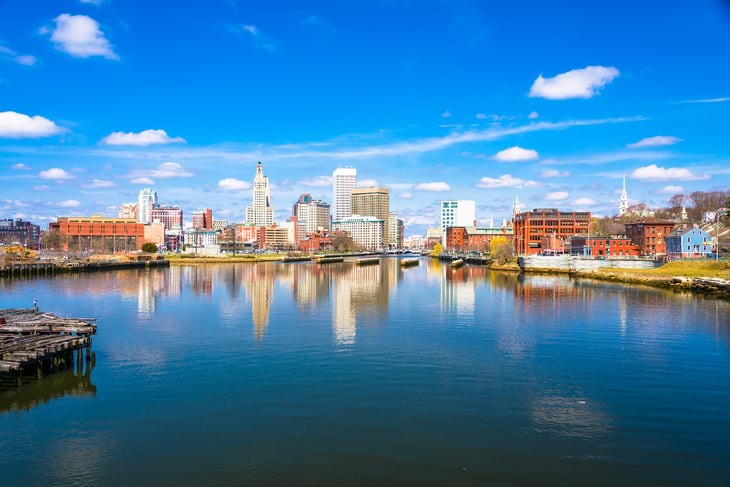
Image source: Getty Images.
Rent affordability rank: 41st
Unemployment rank: 49th
Percentage of households that rent: 38.18%
Renters' median annual income: $36,106
Median monthly rent: $998
Rent as a percentage of monthly income: 33.17%
State unemployment rate: 19.87%
Rhode Island's second-largest industry is leisure and hospitality, which helps explain why the state has one of the country's worst unemployment rates at 19.87%. This industry shed 63% of its workforce in April. Healthcare, retail, and professional services laid off more than 15% of their workers.
COVID-19 has hit Rhode Island less hard than nearby New York or New Jersey. Still, Providence County had 1,622 cases per 100,000 residents as of May 22. The state has a fatality rate above 4%, which is certainly better than Michigan's 9.5% but nothing to celebrate, either.
3. (Tie) Connecticut
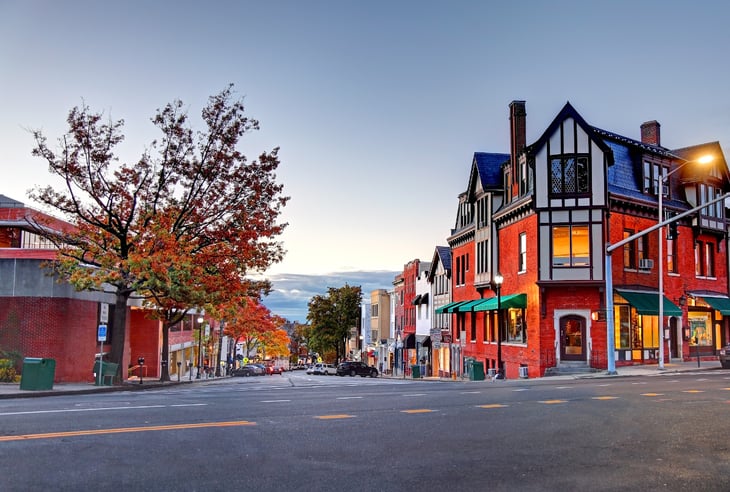
Image source: Getty Images.
Rent affordability rank: 48th
Unemployment rank: 47th
Percentage of households that rent: 34.20%
Renters' median annual income: $40,461
Median monthly rent: $1,171
Rent as a percentage of monthly income: 34.73%
State unemployment rate: 19.33%
Connecticut has one of the highest infection rates in the country. And its renters are tied with New York's in shouldering the heaviest economic burden. Both states' renters live in some of the most unaffordable housing in the country and have suffered some of the highest unemployment rates.
The good news is that, as of May 22, infections in Connecticut have declined steadily for the last month, and the economy is slowly reopening, meaning some residents will be able to return to work at least part-time. Will that result in economic improvements, or just more cases? That remains to be seen.
3. (Tie) New York

Image source: Getty Images.
Rent affordability rank: 47th
Unemployment rank: 48th
Percentage of households that rent: 46.33%
Renters' median annual income: $44,276
Median monthly rent: $1,274
Rent as a percentage of monthly income: 34.53%
State unemployment rate: 19.62%
New York's rent affordability and unemployment rankings are the mirror image of Connecticut's, tying the states for 50th place. These are the states where the pandemic economy has hurt renters the most.
New York has a huge percentage of renters; only D.C. has more. In New York City, rentals are notoriously small, low-quality, and hard to come by. The city's five boroughs include three that rank in the top four for the highest COVID-19 county caseloads in the United States. As of May 22, Queens had 59,615 confirmed cases, Kings had 53,137, and the Bronx had 43,918.
1. Puerto Rico
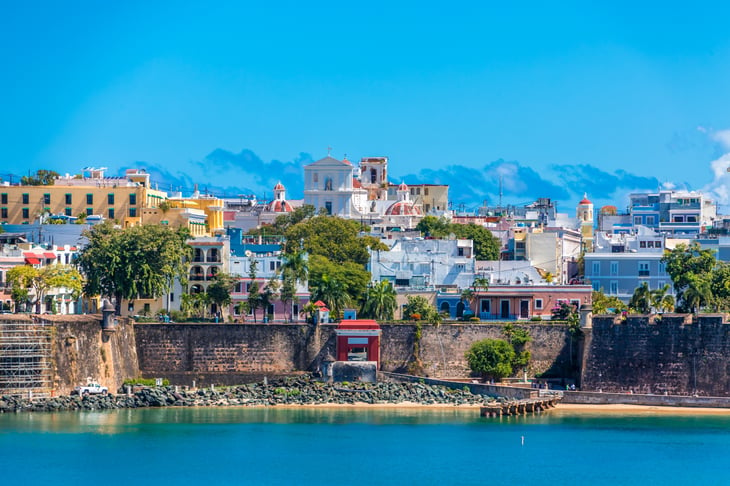
Image source: Getty Images.
Rent affordability rank: 52nd
Unemployment rank: 46th
Percentage of households that rent: 32.71%
Renters' median annual income: $11,749
Median monthly rent: $484
Rent as a percentage of monthly income: 49.43%
State unemployment rate: 19.16%
Puerto Rico was recently battered by earthquakes and hurricanes; it has also struggled through more than a decade of negative economic growth. After seeing more than its fair share of adversity, things have only gotten worse.
The confirmed case count in Puerto Rico is 3,100 with 127 deaths. Like many U.S. states, these numbers are believed to be an undercount, but this is especially true in Puerto Rico, which has been scandalized by its bungled testing program. However, Puerto Rico's governor swiftly imposed a strict lockdown on March 15 that included a nightly curfew punishable by a $5,000 fine or six months in jail; perhaps it had the intended effect of keeping the pandemic under control.
Methodology
To calculate rent as a percentage of monthly income, we divided each state's median monthly rent by the state's renters' median monthly income (both data points come from the latest version of the U.S. Census Bureau's American Community Survey, found in table S2503).
State unemployment rates are from the U.S. Department of Labor's Unemployment Insurance Weekly Claims data released May 21, 2020. This data release covers claims filed for the work week that ended May 2.
All 50 states, the District of Columbia, and Puerto Rico were ranked on both factors. Final ranks were calculated using both ranks as equally weighted factors.
The percentage of households that rent is from the U.S. Census Bureau's American Community Survey data, table S2503.
All data on infection rates, cases, and deaths are from Johns Hopkins Coronavirus Resource Center.
Sources
- Johns Hopkins Coronavirus Resource Center (2020). COVID-19 United States Cases by County.
- U.S. Census Bureau (2018). American Community Survey - Table S2503, "Financial Characteristics."
- U.S. Department of Labor (2020). Unemployment Insurance Weekly Claims Data. Homeowners with fixed-rate mortgages will never see their monthly payment rise, and those with paid-off mortgages can stay put as long as they pay their taxes
Our Research Expert
We're firm believers in the Golden Rule, which is why editorial opinions are ours alone and have not been previously reviewed, approved, or endorsed by included advertisers. The Ascent does not cover all offers on the market. Editorial content from The Ascent is separate from The Motley Fool editorial content and is created by a different analyst team. The Motley Fool has a Disclosure Policy. The Author and/or The Motley Fool may have an interest in companies mentioned.